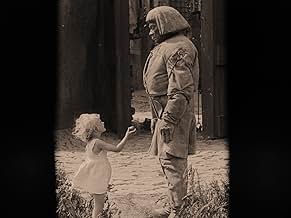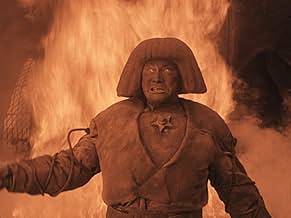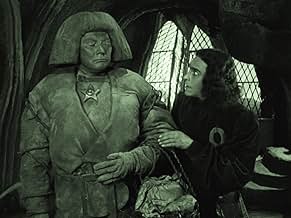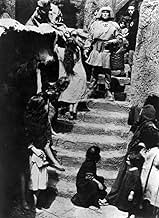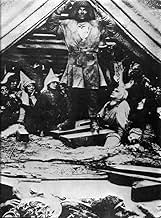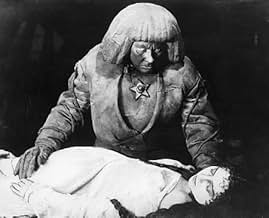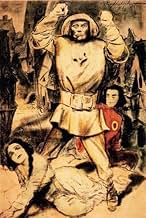IMDb-BEWERTUNG
7,2/10
9143
IHRE BEWERTUNG
Im Prag des 16. Jahrhundert erschafft ein Rabbi den Golem - eine riesige Figur aus Lehm. Mithilfe der Zauberei erweckt er die Kreatur zum Leben, um die Prager Juden vor der Verfolgung zu sch... Alles lesenIm Prag des 16. Jahrhundert erschafft ein Rabbi den Golem - eine riesige Figur aus Lehm. Mithilfe der Zauberei erweckt er die Kreatur zum Leben, um die Prager Juden vor der Verfolgung zu schützen.Im Prag des 16. Jahrhundert erschafft ein Rabbi den Golem - eine riesige Figur aus Lehm. Mithilfe der Zauberei erweckt er die Kreatur zum Leben, um die Prager Juden vor der Verfolgung zu schützen.
- Regie
- Drehbuch
- Hauptbesetzung
- Auszeichnungen
- 1 Gewinn & 1 Nominierung insgesamt
Hans Stürm
- Der Rabbi Jehuda, der Älteste der Gemeinde
- (as Hans Sturm)
Carl Ebert
- Temple Servant
- (Nicht genannt)
Fritz Feld
- Jester
- (Nicht genannt)
Loni Nest
- Ein kleines Mädchen
- (Nicht genannt)
- …
Ursula Nest
- Little Girl
- (Nicht genannt)
Dore Paetzold
- Des Kaisers Kebse
- (Nicht genannt)
- …
Märte Rassow
- Kind
- (Nicht genannt)
Empfohlene Bewertungen
"Der Golem" is surely one of the best German expressionist silent movies. It may be second only to "The Cabinet of Doctor Caligari"; I enjoyed it as much as Murnau's "Faust", and, truth be told, more than "Nosferatu".
You probably already know the story: it's a well-known Jewish folk tale about a rabbi who constructs a stone creature (a golem) to protect his fellows from an anti-Semitic government in medieval Prague. The creature impresses the gentiles, but then it turns on its master.
These movies aren't really about plot, nor characters. They're about mood, setting, and mise-en-scene. The golem itself is an indelible image; surprisingly it was played by the writer-director himself, who must have been a massive person. You can see the influence on James Whale's classic "Frankenstein". The settings are also sumptuous and fitting.
My mind did wander, but not as much as when I watched Swedish silent "Korkarlen", also a horror film based on local myth. I appreciated that the story was easy to follow and interesting.
You probably already know the story: it's a well-known Jewish folk tale about a rabbi who constructs a stone creature (a golem) to protect his fellows from an anti-Semitic government in medieval Prague. The creature impresses the gentiles, but then it turns on its master.
These movies aren't really about plot, nor characters. They're about mood, setting, and mise-en-scene. The golem itself is an indelible image; surprisingly it was played by the writer-director himself, who must have been a massive person. You can see the influence on James Whale's classic "Frankenstein". The settings are also sumptuous and fitting.
My mind did wander, but not as much as when I watched Swedish silent "Korkarlen", also a horror film based on local myth. I appreciated that the story was easy to follow and interesting.
At the beginning of the DvD's "scrapbook", there is a quote from Paul Wegener that says he never thought the Golem was an expressionist film. Watching it right after seeing Nosferatu, that statement becomes believable. Despite amazing sets that would have been at home in Caligari, in story, in acting, and in overall tone, The Golem is a much more naturalistic film. Watching it with my son, who is 16, he was struck by its uncomfortable prefiguring of Jewish persecution. I was impressed by the the scarcity of romantic cliches in the story. The golem itself is clearly the ancestor of the Frankenstein monster. Full of wonderful images and interesting as a predecessor of the Universal monster films, The Golem is also very entertaining as a story and as a piece of dramatic film making. Highly recommended.
Although this 1920 German silent does not really rank alongside the truly great silent films, it remains a fascinating oddity. Based on European Jewish folklore, it tells the story a Jewish community in Prague which is threatened with expulsion from the city. In an effort to protect his people, Rabbi Loew creates a man-like creature made of clay and uses it to impress the Emperor. Unfortunately, the magic backfires, and when the Golem falls into the hands of the Rabbi's perfidious assistant disaster results.
Much of the film's charm is in its visual style. The sets by Hans Poelzig are a strange but cohesive mixture of medieval, nouveau, and surrealism, and the cinematography by legendary photography Karl Freund uses high contrast black and white to truly remarkable effect. The Poelzig-Freund combination would cast an extremely long shadow, and THE GOLEM would influence not only such German films as Fitz Lang's METROPOLIS but the entire cycle of 1930s American horror films that began with the 1931 Bela Lugosi Dracula.
Several plot devices and the look of the Golem, as played by Paul Wegener, would also prove particularly influential for director James Whale's famous 1932 FRANKENSTEIN. Whether or not Boris Karloff or make-up artist Jack Pierce knew the film is uncertain--but Whale, who was fond of German cinema, certainly did, and traces of THE GOLEM can be seen throughout his most famous works.
Over the past several decades a number of film historians have attempted to reinterpret THE GOLEM in light of the Holocaust. There may actually be a certain validity to this, for although the Jews are portrayed sympathetically they are very clearly outsiders, and their religion seems less like religion than witchcraft--and indeed Rabbi Loew might be said to practice black magic in bringing the Golem to life. This sense of social estrangement and religious stigmatism does seem indicative of the anti-Semitism that will ultimately explode into furnaces of Nazi Germany. All the same, it is worth noting that THE GOLEM is a fundamentally Jewish story to begin with, and it is perhaps best to think of it in those terms instead of using hindsight to impose modern meanings upon the film.
There are several home market releases of the film. While I have not seen it, I am told the Timeless Studios VHS release is weak; I have, however, seen the Gotham DVD release, and although there are some quality issues this inexpensive DVD is not at all bad. Still, my preference and recommendation is the Kino DVD. Unlike many Kino editions, it does not have anything significant in the way of bonuses, but the overall presentation is very fine and likely represents a best-possible presentation short of full digital restoration.
Much of the film's charm is in its visual style. The sets by Hans Poelzig are a strange but cohesive mixture of medieval, nouveau, and surrealism, and the cinematography by legendary photography Karl Freund uses high contrast black and white to truly remarkable effect. The Poelzig-Freund combination would cast an extremely long shadow, and THE GOLEM would influence not only such German films as Fitz Lang's METROPOLIS but the entire cycle of 1930s American horror films that began with the 1931 Bela Lugosi Dracula.
Several plot devices and the look of the Golem, as played by Paul Wegener, would also prove particularly influential for director James Whale's famous 1932 FRANKENSTEIN. Whether or not Boris Karloff or make-up artist Jack Pierce knew the film is uncertain--but Whale, who was fond of German cinema, certainly did, and traces of THE GOLEM can be seen throughout his most famous works.
Over the past several decades a number of film historians have attempted to reinterpret THE GOLEM in light of the Holocaust. There may actually be a certain validity to this, for although the Jews are portrayed sympathetically they are very clearly outsiders, and their religion seems less like religion than witchcraft--and indeed Rabbi Loew might be said to practice black magic in bringing the Golem to life. This sense of social estrangement and religious stigmatism does seem indicative of the anti-Semitism that will ultimately explode into furnaces of Nazi Germany. All the same, it is worth noting that THE GOLEM is a fundamentally Jewish story to begin with, and it is perhaps best to think of it in those terms instead of using hindsight to impose modern meanings upon the film.
There are several home market releases of the film. While I have not seen it, I am told the Timeless Studios VHS release is weak; I have, however, seen the Gotham DVD release, and although there are some quality issues this inexpensive DVD is not at all bad. Still, my preference and recommendation is the Kino DVD. Unlike many Kino editions, it does not have anything significant in the way of bonuses, but the overall presentation is very fine and likely represents a best-possible presentation short of full digital restoration.
This is, currently, the only silent movie I have ever seen, and I was unsure how I'd take it. I had heard a lot about this movie and was expecting big things, and I must say I was impressed.
The only major complain I have is that, as with many older classics, I read a review of it prior to buying in which the reviewer gave WAY too much away (the ending sequence, namely).. this has happened to me far too many times. I really wish reviewers wouldn't assume that everyone has already seen the movies they are reviewing, just because they are 'classics'. It really dampened my experience with the ending of both this movie, and The Man with X-Ray Eyes, just to name a few.
Anywho, the version I saw (the Kino remaster) was great. The picture quality was about as good as you could expect from a film more than 80 years old. The score was very good, maybe a tad repetitive, but it suit the film. The acting is quite good, very reminiscant of the acting style from the mid-to-early 20th century.
The scare factor? Well, probably not much these days. The Jewish ghetto is very well constructed, and really suits the setting. The golem himself is not so scary, more goofy to me, but to people in 1920, I can imagine he could have been quite scary. This is more of an 'interest' movie, than an all-out scare fest. You can really see where so many of the great horror/scare films over the years got their ideas from after seeing early films such as this.
I would definately recommend everyone who is interested in horror to track it down. Don't be put off by the fact that it's a silent film, it took all of 20 seconds for me to forget that completely, and to just enjoy the film.
The only major complain I have is that, as with many older classics, I read a review of it prior to buying in which the reviewer gave WAY too much away (the ending sequence, namely).. this has happened to me far too many times. I really wish reviewers wouldn't assume that everyone has already seen the movies they are reviewing, just because they are 'classics'. It really dampened my experience with the ending of both this movie, and The Man with X-Ray Eyes, just to name a few.
Anywho, the version I saw (the Kino remaster) was great. The picture quality was about as good as you could expect from a film more than 80 years old. The score was very good, maybe a tad repetitive, but it suit the film. The acting is quite good, very reminiscant of the acting style from the mid-to-early 20th century.
The scare factor? Well, probably not much these days. The Jewish ghetto is very well constructed, and really suits the setting. The golem himself is not so scary, more goofy to me, but to people in 1920, I can imagine he could have been quite scary. This is more of an 'interest' movie, than an all-out scare fest. You can really see where so many of the great horror/scare films over the years got their ideas from after seeing early films such as this.
I would definately recommend everyone who is interested in horror to track it down. Don't be put off by the fact that it's a silent film, it took all of 20 seconds for me to forget that completely, and to just enjoy the film.
The giant frame of Paul Wegener as the Golem is one of the best known characters from the silent era, and one of the first icons of horror. Der Golem is actually the third film to feature the character, the first being The Golem (1915), and the second The Golem And The Dancing Girl (1917), which is a short comedy with Wegener donning the costume to frighten a girl he is in love with. Tragically, those two films are now considered lost, and only fragments equalling about 14 minutes of the first film remain. This film is actually a prequel, and it's full title is Der Golem: Wie Er In Die Welt Kam (How He Came Into The World), but is now commonly know as simply Der Golem.
The Jews of medieval Prague face persecution from the townsfolk. Terrified of their doomed fate, Rabbi Loew (Albert Steinruck) uses his skills in black magic to create The Golem, a mythical figure from Jewish folklore. He is made entirely from clay, and has an amulet in his chest that gives him power, and when removed turns him back into lifeless clay. He is initially used as a servant, and then to terrify the townsfolk who are threatening them. The Golem eventually gets tired of being used as a tool of fear and begins to turn on his creator, and starts to lay waste to the Ghetto.
Like the majority of films made in Weimar Germany, the film has an expressionist tone, with lavish, artistic sets that dominate the frame. Similar in feel to the great Das Cabinet Des Dr. Caligari, it is however more subtle in its artistic flair, and lacks Caligari's rickety (although wonderful in its own way) sets. It is also quite terrifying in its realisation of a segregation that would occur in the country only a decade later, although it does portray the Jews as vengeful and as studying the dark arts.
The Golem itself is a great movie monster. Tragic in the same way as Frankenstein's monster, he is brought into the world without having asked to be, and is expected to carry out terrible acts against his will. Paul Wagener portrays him with all silent intensity and uncontrollable rage, with his towering frame sending his enemies running for the hills. He also impressively co-wrote and co-directed the film. This is an enjoyable film that breezes by in its rather slight running time, and can be forgiven for some over-acting and the occasional tedious scene. It also has some interesting social comments, and is a frightening prelude to one of the most horrific periods in Europe's history.
www.the-wrath-of-blog.blogspot.com
The Jews of medieval Prague face persecution from the townsfolk. Terrified of their doomed fate, Rabbi Loew (Albert Steinruck) uses his skills in black magic to create The Golem, a mythical figure from Jewish folklore. He is made entirely from clay, and has an amulet in his chest that gives him power, and when removed turns him back into lifeless clay. He is initially used as a servant, and then to terrify the townsfolk who are threatening them. The Golem eventually gets tired of being used as a tool of fear and begins to turn on his creator, and starts to lay waste to the Ghetto.
Like the majority of films made in Weimar Germany, the film has an expressionist tone, with lavish, artistic sets that dominate the frame. Similar in feel to the great Das Cabinet Des Dr. Caligari, it is however more subtle in its artistic flair, and lacks Caligari's rickety (although wonderful in its own way) sets. It is also quite terrifying in its realisation of a segregation that would occur in the country only a decade later, although it does portray the Jews as vengeful and as studying the dark arts.
The Golem itself is a great movie monster. Tragic in the same way as Frankenstein's monster, he is brought into the world without having asked to be, and is expected to carry out terrible acts against his will. Paul Wagener portrays him with all silent intensity and uncontrollable rage, with his towering frame sending his enemies running for the hills. He also impressively co-wrote and co-directed the film. This is an enjoyable film that breezes by in its rather slight running time, and can be forgiven for some over-acting and the occasional tedious scene. It also has some interesting social comments, and is a frightening prelude to one of the most horrific periods in Europe's history.
www.the-wrath-of-blog.blogspot.com
Wusstest du schon
- Wissenswertes"Aemaet", the life-giving word which Rabbi Lowe compels from the spirit Astaroth is also reflected in the bolts of lightning at the end of the creation scene.
- PatzerThe story is set in the 16th Century. A prediction of doom is made based on the movements of Uranus, which was not discovered until 1781.
- Alternative VersionenThe 2002 Alpha Video DVD version runs for 101 minutes. This is not evident from the back of the Alpha Video DVD case, which wrongly lists the running time as only 85 minutes. It looks as if Alpha Video somehow got hold of the fullest version currently known - maybe even a complete version of the film, since there are no obvious gaps in the story.
- VerbindungenEdited into People Who Die Mysteriously in Their Sleep (2004)
Top-Auswahl
Melde dich zum Bewerten an und greife auf die Watchlist für personalisierte Empfehlungen zu.
- How long is The Golem?Powered by Alexa
Details
- Erscheinungsdatum
- Herkunftsland
- Sprache
- Auch bekannt als
- Der Golem - Wie er in die Welt kam
- Drehorte
- Produktionsfirma
- Weitere beteiligte Unternehmen bei IMDbPro anzeigen
- Laufzeit1 Stunde 16 Minuten
- Farbe
- Sound-Mix
- Seitenverhältnis
- 1.33 : 1
Zu dieser Seite beitragen
Bearbeitung vorschlagen oder fehlenden Inhalt hinzufügen

Oberste Lücke
By what name was Der Golem, wie er in die Welt kam (1920) officially released in India in English?
Antwort

